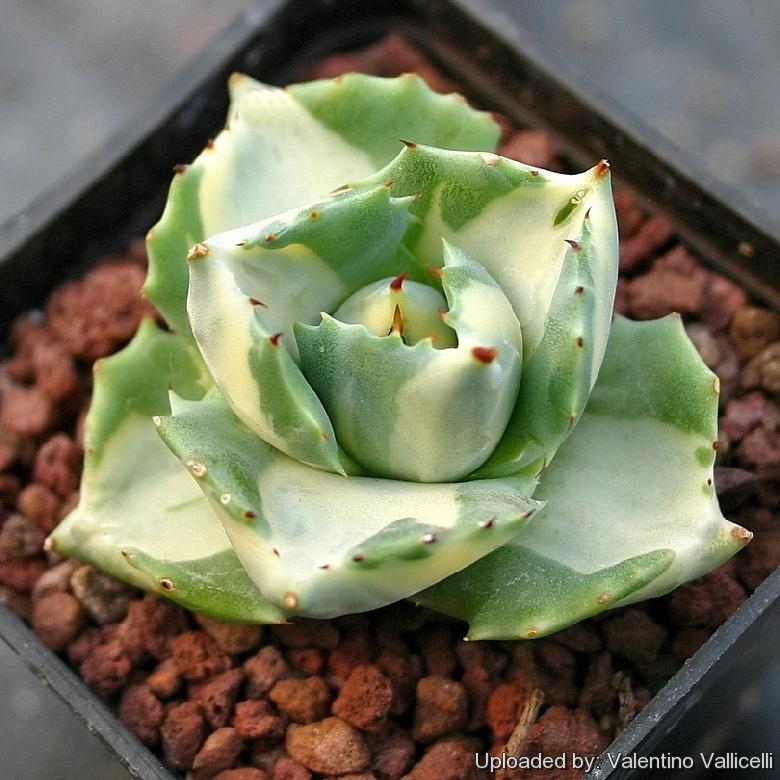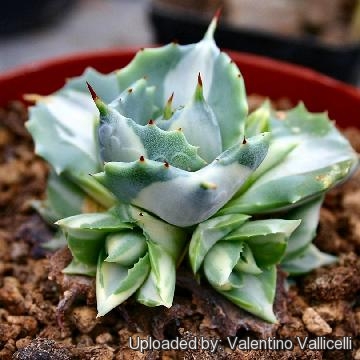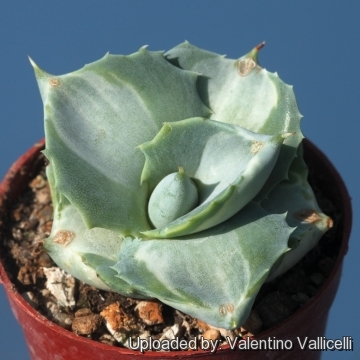Accepted Scientific Name: Agave isthmensis cv. Orhi Razin Shirifukurin

Agave isthmensis Orhi Razin Shirifukuri
Dwarf, small growing, variegated form that looks like a rose bud, the smooth grey-green leaves have a broad cream/white band on the centre.
Origin and Habitat: Garden origin (Nursery selected cultivar)
Synonyms:
See all synonyms of Agave isthmensis
back
Accepted name in llifle Database:Agave isthmensis García-Mendoza. & F.PalmaSida 15: 565 (-567), fig. 1. 1993
Cultivars
(1):
back
Description: It is the dwarf, small growing, variegated form of Agave istmensis (potatorum). This cultivar is also found under a few different names such as: Agave istmensis f. compacta mediopicta, or with the Japanese names Agave isthmensis cv. Orhi Razin Shirifukurin, Ouhi-Raiji or symply Hoi. Other names include: Agave potatorum cv. Ouhi-Raijin variegata. It shoots off pups/offsets readily as the mother plant matures.
Stem: Acaulescent.
Rosettes:Compact, looking like a rose buds, that grows to only 5-7 cm tall by about 9-12 cm wide.
Leaves: Essentially smooth light blue-grey-green to olive green, very broadly triangular, with a short non prickly apical spine, openly concave (spoon-shaped), margined with with short somewhat flexible spine, from purple-chestnut becoming dull gray-brown. Each lef has a broad white cream white band on the center. The margins occasionally have a seasonal slight flush of red at the leaf tip and base. Marginal spines are well spaced.
Subspecies, varieties, forms and cultivars of plants belonging to the Agave isthmensis group
 Agave potatorum cv. Hoi (Agave isthmensis cv. Orhi Razin Shirifukurin) Photo by: Valentino Vallicelli
Agave potatorum cv. Hoi (Agave isthmensis cv. Orhi Razin Shirifukurin) Photo by: Valentino Vallicelli Agave potatorum cv. Hoi (Agave isthmensis cv. Orhi Razin Shirifukurin) Photo by: Valentino Vallicelli
Agave potatorum cv. Hoi (Agave isthmensis cv. Orhi Razin Shirifukurin) Photo by: Valentino VallicelliCultivation and Propagation: It is a smal specimen plant for containers. It tend to be slow grower, but worth the effort. Grow it in porous soil with adequate drainage. Itdo well in full sun or a lightly shaded area. Water thoroughly when soil is dry to the touch. In winter watering this plant can be done once every 1-2 months, there is no need to mist the leaves. It is theoretically hardy to -3° C, particularly when dry but it is best to avoid severe freezing temperatures. Heat Tolerance: good
Propagation: Relatively easy to propagate by suckers (if available) Remove the basal suckers in spring or summer and let the cuttings dry for a few days before inserting in compost.. only problem is the logistics of getting to the suckers - very sharp spines and suckers usually right up against, or underneath the mother plant.












